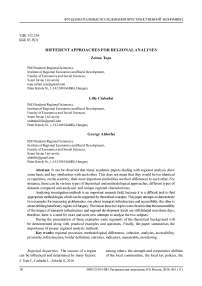Different approaches for regional analyses
Автор: Topa Zoltan, Czabadai Lilla, Aldorfai Gyorgy
Журнал: Региональная экономика. Юг России @re-volsu
Рубрика: Фундаментальные исследования пространственной экономики
Статья в выпуске: 1 (11), 2016 года.
Бесплатный доступ
It can be observed that many academic papers dealing with regional analysis show some basic and key similarities with each other. This does not mean that they would be too identical or repetitive; on the contrary, their most important similarities are their differences to each other. For instance, there can be various types of theoretical and methodological approaches, different types of datasets compared and analysed, and unique regional characteristics. Analysing investigation methods is an important research field, because it is a difficult task to find appropriate methodologies which can be supported by theoretical concepts. This paper attempts to demonstrate two examples for measuring problematics: one about transport infrastructure and accessibility, the other is about defining beneficiary regions in Hungary. The reason these two topics were chosen is that the measurability of the impact of transport infrastructure and regional development levels are still debated even these days; therefore, there is a need for more and more new attempts to analyse the two subjects. During the presentation of these examples some segments of the theoretical background will be demonstrated along with practical examples and questions. Finally, the paper summarises the importance of proper regional analytic methods.
Regional processes, methodological differences, cohesion, analyses, accessibility, proximity, infrastructure, border definition, statistics, indicators, measurable, monitoring
Короткий адрес: https://sciup.org/149131106
IDR: 149131106
Список литературы Different approaches for regional analyses
- Act XXI of 1996 on Regional Development and Land Use. Available at: http://net.jogtar.hu/jr/gen/hjegy_doc.cgi?docid=99600021.TV.
- African Cities Are Starting to Look Eerily Like Chinese Ones. Available at: http://www.citylab.com/design/2015/08/african-cities-are-starting-to-look-eerily-like-chinese-ones/401432/?utm_source=SFFB.
- Bakucz M., Bozóti A., Kovács Á. A közúti elérhetőség szerepe a hazai fürdőtelepülések turisztikai versenyképességében . Területi Statisztika, 2015, no. 55/1, pp. 60-75.
- Enyedi Gy. Globalizáció és a magyar területi fejlődés . Tér és Társadalom, 2011, no. 1, pp. 1-10.
- Government Regulation on the Classification of Beneficiary Districts. 290/2014 (XI. 26). Available at: http://hirlevel.egov.hu/2014/11/27/a-kormany-2902014-xi-26-korm-rendelete-a-kedvezmenyezett-jarasok-besorolasarol.
- Government Regulation on the Classification of the Beneficiary Regions. 311/2007 (XI. 17). Available at: http://www.njt.hu/cgi_bin/njt_doc.cgi?docid=112557.215415.
- Government Regulation on the Identification and Classification of Micro-Regions. 244/2003 (XII. 18).Available at: http://net.jogtar.hu/jr/gen/hjegy_doc.cgi?docid=A0300244.KOR.
- Hungarian Central Statistics Office. Budapest, Prospectus About the Supported Micro-Regions Publ., 2008. 52 p.
- Japan Has Invested More Africa Project Financing Than China. Available at: http://www.bloomberg.com/news/articles/2015-03-24/japan-has-invested-more-africa-project-financing-than-china.
- Káposzta J., Nagy H. Status Report About the Progress of the Visegrad Countries in Relation to Europe 2020 Targets. European Spatial Research and Policy, 2015, no. 22, pp. 81-99.
- Káposzta J. Területi különbségek kialakulásának főbb összefüggései . Gazdálkodás, 2014, no. 58, pp. 399-412.
- Laksh manan T.R. The Broader Economic Consequences of Transport Infrastructure Investments. Journal of Transport Geography, 2011, no. 19, pp. 1-12.
- Map of Beneficiary Districts 2015. Available at: http://www.terport.hu/tematikus-terkepek/kedvezmenyezett-jarasok-a-2902014-xi-26-korm-rendelet-szerint.
- Ministry of Local Government and Regional Development, Hungarian Central Statistics Office. Budapest, Prospectus About Materials and Methods Using in Categorization of Beneficiary Micro-Regions Publ., 2007. 65 p.
- Olsson J. Improved Road Accessibility and Indirect Development Effect: Evidence From Rural Philippines. Journal of Transport Geography, 2009, no. 17, pp. 476-483.
- Oosterhaven J., Knaap T. Spatial Economic Imp acts of Tr an spor t In fr as tr uctu r e In vestmen ts. Pearman A., Mackie P., Nellthorp J., ed. Transport Projects, Programmes and Policies: Evaluation Needs and Capabilities. Aldershot, Ashgate, 2003. 271 p.
- Parliament Resolution on the Principles of Regional Development Subsidies and Decentralization, and the Classification Criteria of Beneficiary Regions. 24/2001 (IV. 20). Available at: http://mkogy.jogtar.hu/?page=show&docid=a01h0024.OGY.
- Parliament Resolution on the Principles of Regional Development Subsidies and Decentralization, and the Classification Criteria of Beneficiary Regions. 67/2007 (VI. 28). Available at: http://mkogy.jogtar.hu/?page=show&docid=a07h0067.OGY.
- Péli T., Neszmélyi Gy. I. Territorial Differences of Rural Cities and the Development of Transport Infrastructure in Hungary. Romanian Review of Regional Studies, 2015, no. 2, pp. 51-66.
- Snieska V., Simkunaite I. Socio-Economic Impact of Infrastructure Investments. Economics of Engineering Decisions, 2009, no. 3, pp. 1-10.
- Tiner T. Az ipari parkok elérhetőségének szerepe a nemzetközi és hazai szakirodalomban . Földrajzi Közlemények, 2011, no. 3, pp. 291-299.
- Yu N., De Jong M., Storm S., Mi J. The Growth Impact of Transport Infrastructure Investment. Policy and Society, 2012, no. 31, pp. 25-38.


